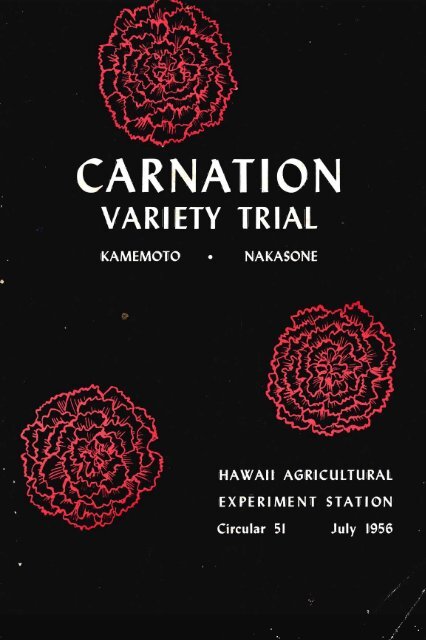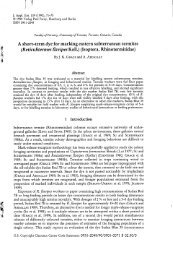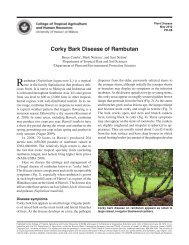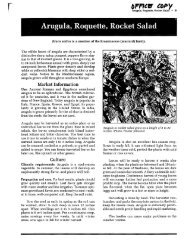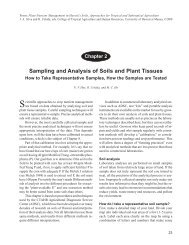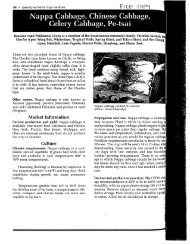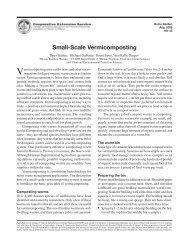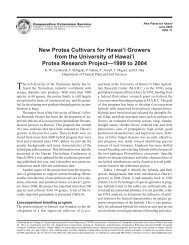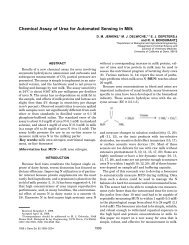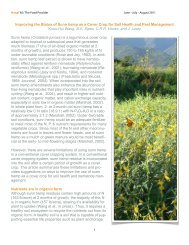Carnation variety trial - ctahr - University of Hawaii
Carnation variety trial - ctahr - University of Hawaii
Carnation variety trial - ctahr - University of Hawaii
Create successful ePaper yourself
Turn your PDF publications into a flip-book with our unique Google optimized e-Paper software.
INTRODUCTION<br />
SOURCE OF PLANTS<br />
GENER
THE AUTHORS<br />
Dr. Haruyuki Kamemoto is associate horticulturist at the Station and<br />
pr<strong>of</strong>essor <strong>of</strong> agriculture at the <strong>University</strong>.<br />
Mr. Henry Y. Nakasone is junior horticulturist at the Station and<br />
instructor in agriculture at the <strong>University</strong>.
CARNATION VARIETY TRIAL<br />
H. Kamemoto • H. Y. Nakasone<br />
INTRODUCTION<br />
The carnation, one <strong>of</strong> the most important commercial field-grown floricultural<br />
crops in the Islands, has been under cultivation for several decades.<br />
It has been grown primarily for the lei trade; however, in recent years,<br />
interest in cut-flower production has increased considerably due to the introduction<br />
<strong>of</strong> Mainland commercial varieties.<br />
The major emphasis in the past has been on the production <strong>of</strong> carnations<br />
for lei flowers, and qualities demanded <strong>of</strong> cut flowers were generally ignored.<br />
Consequently, the types grown had small flowers, short stems, and bushy<br />
growths. Many were even grown from seeds, because the requirements for<br />
uniformity were not as rigid as those for cut flowers. The "Pink" is one <strong>of</strong><br />
these varieties; it has been under continuous cultivation for over 40 years and<br />
is still the leading lei <strong>variety</strong> in the Islands. It produces throughout the year<br />
relatively small but highly fragrant flowers on short stems.<br />
The main production areas for lei carnations shifted from Waialae to<br />
Maunalani Heights and now to the Koko Head area. These regions are suitable<br />
for lei flower production, but not for cut-flower production due to the<br />
relatively warm night temperatures. The cut-flower varieties are known to<br />
require cool night temperatures for optimum growth and production. It has<br />
been demonstrated that Kula on Maui and Wahiawa on Oahu are more favorable<br />
locations for cut-flower types. The introduction and culture <strong>of</strong> a few<br />
Mainland varieties in both areas have stimulated interest in such varieties,<br />
not only within these areas but in other carnation-growing areas as well, for<br />
besides the excellent cut flowers obtainable from some <strong>of</strong> these varieties the<br />
larger flowers make large and beautiful leis.<br />
In order to answer some <strong>of</strong> the questions that may arise on the behavior<br />
<strong>of</strong> Mainland varieties, both as cut flowers and as lei flowers, in slightly<br />
warmer areas, a study <strong>of</strong> several Mainland carnation varieties was conducted<br />
at the <strong>University</strong> Farm in Manoa Valley. The results <strong>of</strong> this study are reported<br />
herein.<br />
SOURCE OF PLANTS<br />
Fifty rooted cuttings <strong>of</strong> each <strong>of</strong> 15 carnation varieties were donated by<br />
Yoder Brothers <strong>of</strong> Barberton, Ohio. From Sim <strong>Carnation</strong> Company <strong>of</strong> Saugus,<br />
Massachusetts, 50 rooted cuttings <strong>of</strong> each <strong>of</strong> 6 varieties were received. F. C.<br />
Gloeckner and Company <strong>of</strong> New York gave 50 rooted cuttings <strong>of</strong> each <strong>of</strong> 3<br />
5
varieties with flower sizes approximating 21j2 inches make larger leis measuring<br />
from 31;2 to 4 inches in diameter. The lateral flowers average about 1;4<br />
inch less than the terminals.<br />
Favorable stem lengths were obtained with Apollo, Cassandra, Canary<br />
Queen, Eros, Midas, Siren, Vulcan, Venus, and White Sim, all <strong>of</strong> which averaged<br />
18 inches or longer (Table 1). The Littlefield varieties produced strong<br />
and erect but rather short stems averaging 15 to 16 inches. Saturn and Titan<br />
produced stems averaging 14.5 inches and 13.2 inches, respectively; these<br />
lengths are too short for the cut-flower trade.<br />
For lei flower production, long stems are not required. Short-stemmed<br />
varieties are <strong>of</strong>ten more desirable, for staking may be unnecessary and, also,<br />
the plants are able to better withstand the wind. Titan was one <strong>of</strong> those that<br />
appeared suitable for lei flower production but undesirable for cut-flower<br />
production because <strong>of</strong> the high percentage <strong>of</strong> splits and short stems.<br />
Splitting <strong>of</strong> calyx<br />
One <strong>of</strong> the major problems in carnation culture is the splitting <strong>of</strong> the<br />
calyx. This condition results in an asymmetrical flower through the drooping<br />
<strong>of</strong> some petals at the split region and thus greatly decreases the value <strong>of</strong> the<br />
cut flower. In the case <strong>of</strong> lei flowers, however, splitting <strong>of</strong> the calyx is not an<br />
important factor, for the calyx is generally removed before the flowers are<br />
strung into leis.<br />
Some <strong>of</strong> the causes <strong>of</strong> the calyx splitting are 10 degrees or more drop in<br />
night temperature below the normal, a high level <strong>of</strong> nutrients in the soil, and<br />
a low nitrogen "leveJ.1 It is also known that splitting is an inherent characteristic;<br />
some varieties produce splits regularly while others produce them rarely<br />
or not at all. Inasmuch as splitting considerably reduces the value <strong>of</strong> cut<br />
flowers, it is essential to consider this characteristic in any varietal <strong>trial</strong>.<br />
As shown in Table 1, differences in percentage <strong>of</strong> splits were obtained<br />
among the varieties. Splitting ranged from a high <strong>of</strong> 81 percent for "Pink,"<br />
the local <strong>variety</strong>, to no splitting for Siren. Aurora, Canary Queen, Eros, Fanfare,<br />
Gordon, and Titan produced more than 60 percent spilts, while Cassandra,<br />
Cupid, Apollo, and Vulcan produced less than 3 percent splits. The<br />
Littlefield varieties produced few splits, while White Sim gave about 28<br />
percent splits.<br />
In Figure 2 is shown the monthly percentages <strong>of</strong> splits for several varieties.<br />
The percentage <strong>of</strong> splits for each <strong>variety</strong> did not fluctuate greatly throughout<br />
the year. This means that splitting is influenced primarily by the inherent<br />
nature <strong>of</strong> the <strong>variety</strong> rather than in changes <strong>of</strong> environment such as temperature,<br />
light intensity, daylength, rainfall, irrigation, etc.<br />
Fragrance<br />
The "Pink" <strong>variety</strong> has a strong but pleasant fragrance, which is perhaps<br />
one <strong>of</strong> the reasons for its being the leading lei <strong>variety</strong> in the Islands. The<br />
majority <strong>of</strong> the Mainland varieties lack fragrance or are only faintly scented.<br />
lKenneth Post. Florist Crop Production and Marketing, New York: Orange Judd Publishing<br />
Co., Inc., 1949.<br />
9
"'""'"<br />
"'""'"<br />
TABLE 1. Continued<br />
YEAR'S PRODUCTION<br />
NUMBER OF<br />
April 1954-April1955 AVERAGE FLOWER SIZE PLANTS DEAD<br />
SOURCE I Lei Flow", I Lei Flow", Cut<br />
OF FLOWER Cut Cut STEM Flower Lei<br />
VARIETY PLANTS* COLOR Flower terminal I lateral Flower terminal lateral LENGTH SPLITS Plot Plot<br />
inches inches inches inches 0/0<br />
Minerva 1 Dark pink 429 376 901 2.58 2.52 2.25 17.46 29.37 19 16<br />
"Pink" 5 Pink 871 738 2585 1.95 1.94 1.80 17.90 80.94 3 4<br />
Raspberry Dark<br />
Ice 2 lavender 437 590 1160 2.42 2.47 2.33 17.13 2.28 13 22<br />
Saturn 1 Variegated<br />
bronze 355 327 668 2.43 2.48 2.07 14.51 16.61 11 11<br />
Saugus Pink 2 Dark pink 297 208 447 2.44 2.47 2.22 16.91 36.36 24 22<br />
Sidney<br />
Littlefield 3 Dark pink 454 361 956 2.46 2.62 2.18 15.52 1.32 5 1<br />
Titan 1 Crimson 712 664 1816 2.45 2.43 2.22 13.19 64.88 8 6<br />
Venus 1 Light pink 325 153 262 2.50 2.50 2.23 19.13 4.61 19 8<br />
Vulcan 1 Crimson 870 777 3679 2.29 2.37 1.99 19.20 1.95 2 2<br />
White<br />
Littlefield 3 White 267 306 945 2.41 2.52 2.29 15.09 3.37 5 6<br />
White Sim 2 White 371 290 941 2.60 2.49 2.25 19.16 28.57 9 2<br />
*1 = Yoder Brothers, Inc., Barberton, Ohio<br />
2 =Sim <strong>Carnation</strong> Co., Saugus, Massachusetts<br />
3 = F. C. Gloeckner & Co., Inc., New York, N. Y.<br />
4 = Pr<strong>of</strong>essor Holley, Colorado A. & M. College<br />
5 =<br />
<strong>University</strong> <strong>of</strong> <strong>Hawaii</strong>,<br />
Honolulu, <strong>Hawaii</strong>
Aurora was the only introduced <strong>variety</strong> that approached the strong fragrance<br />
<strong>of</strong> "Pink." Venus and Jupiter were moderately fragrant, but the rest <strong>of</strong> the<br />
varieties were odorless. If fragrance is a requisite <strong>of</strong> a lei <strong>variety</strong>, then the<br />
only Mainland varieties that can qualify are Aurora, Venus, and Jupiter.<br />
EVALUATION OF INDIVIDUAL VARIETIES<br />
Achilles<br />
Medium large white flowers. Production was fair to poor due to unthrifty<br />
growth and high mortality as the <strong>trial</strong> progressed. Stems were crooked and<br />
tended to recline.<br />
Apollo<br />
Medium large light-pink flowers. Production was outstanding. It was<br />
a vigorous grower with strong come-back ability. Stems were thick, sturdy,<br />
and erect. Very few splits occurred. It was one <strong>of</strong> the outstanding varieties<br />
in the <strong>trial</strong>.<br />
Aurora<br />
Very large white flowers. This <strong>variety</strong> was a good grower and heavy<br />
producer until diseases hit it and caused heavy mortality. Despite this, production<br />
was good. This <strong>variety</strong> splits excessively and, therefore, is not recommended<br />
for cut flowers. However, the large, many-petaled, highly fragrant<br />
flowers make the <strong>variety</strong> ideal for lei flower production.<br />
Baby Bronze<br />
Small bronze flowers. The stems were weak and sprawling. Leaves were<br />
yellowish and plants were generally unthrifty. Production was poor. The<br />
<strong>variety</strong> is not recommended for either lei or cut flowers.<br />
Canary Queen<br />
Large yellow flowers. Production was very poor. Most <strong>of</strong> the plants died<br />
before the termination <strong>of</strong> the test. Splitting percentage was also high. It is<br />
not recommended for either cut-flower or lei production.<br />
Cassandra<br />
Large bronzy yellow, variegated with pink. Stems were long and sturdy.<br />
Very rarely did it produce splits. Production was fair. It should be a fair<br />
cut flower <strong>variety</strong> in the yellow-bronze group.<br />
Cupid<br />
Small pink flowers. This was a vigorous grower and heavy producer. Its<br />
come-back ability was very good. Stems were sturdy. Except for the small<br />
size <strong>of</strong> flowers this is an excellent performer.<br />
Durango<br />
Medium dark-red flowers. Production was only fair. Stems were long<br />
and straight but slightly weak. Percentage <strong>of</strong> splits was high.<br />
12
Eros<br />
Large light-pink flowers. It was a vigorous grower with long erect stems.<br />
Production was good, but because <strong>of</strong> the high degree <strong>of</strong> splitting it is not<br />
recommended for cut flowers. The lateral flowers do not develop well and,<br />
therefore, the <strong>variety</strong> may not be suitable for leis either.<br />
Fanfare<br />
Very large dark-pink flowers. Production was fair. This <strong>variety</strong> produced<br />
considerable number <strong>of</strong> splits.<br />
Gordon<br />
Large light-pink flowers. Production <strong>of</strong> cut flowers was fair but the production<br />
<strong>of</strong> lei flowers was poor due to few lateral flowers. Stem length was<br />
short. It produced excessively high percentage <strong>of</strong> splits and, therefore,<br />
coupled with short stems it is undesirable as a cut-flower <strong>variety</strong>.<br />
Juno<br />
Medium-sized white flowers. Production was good as cut flowers but poor<br />
as lei flowers. Stems were short and crooked. Twenty-one percent <strong>of</strong> flowers<br />
produced were splits.<br />
Jupiter<br />
Large white flowers. The first growths were strong and erect and produced<br />
large attractive flowers. However, the come-back ability was poor, and during<br />
the summer months most <strong>of</strong> the plants perished. Twelve percent <strong>of</strong> the flowers<br />
were splits.<br />
Light-Pink Littlefield<br />
Large light-pink flowers. The rooted cuttings were not in as good a condition<br />
as the other varieties. Some <strong>of</strong> the leaves were afflicted with rust disease<br />
and, therefore, the plants did not do well in the early stages. However, the<br />
come-back ability was fairly good. Stems were erect, sturdy, and <strong>of</strong> good<br />
length. Splitting occurred rarely. It should serve as a cut-flower <strong>variety</strong>.<br />
Midas<br />
Medium-sized yellow flowers. Production was very poor. Plants in the lei<br />
section died early in the test and, consequently, no record is available for lei<br />
flowers. It is not recommended because <strong>of</strong> its poor performance.<br />
Minerva<br />
Large dark-pink flowers. At the outset, growth was vigorous and production<br />
was very good. However, during the summer a great number <strong>of</strong> the plants<br />
succumbed. It is probably unadapted to hot summer conditions. The percentage<br />
<strong>of</strong> splits was high. The color tends to bleach during sunny days.<br />
"Pink"<br />
Small pink flowers. This <strong>variety</strong> produced weak stems, small flowers, and<br />
a high percentage <strong>of</strong> splits and, therefore, is entirely unsuitable for cut-flower<br />
production. However, for lei flowers it is outstanding. It was a vigorous<br />
14
grower and produced a great quantity <strong>of</strong> highly fragrant flowers. It sends out<br />
a number <strong>of</strong> shoots from the lower portions <strong>of</strong> the stems, which facilitates<br />
propagation <strong>of</strong> the <strong>variety</strong>.<br />
Raspberry Ice<br />
Medium-sized dark-lavender flowers. Production was fair. Stems were<br />
erect. Percentage <strong>of</strong> splits was low.<br />
Saturn<br />
Medium-sized variegated bronze flowers. Leaves were yellowish, and<br />
plants were not thrifty. Production was poor. The stems were short. The<br />
flowers are highly attractive but the poor production may not warrant the<br />
commercial culture <strong>of</strong> this <strong>variety</strong>.<br />
Saugus Pink<br />
Medium large dark-pink flowers. It was a weak grower and poor producer.<br />
The mortality rate was extremely high. Splitting was common. It is a <strong>variety</strong><br />
unadapted for the present location.<br />
Sidney Littlefield<br />
Large dark-pink flowers. Behavior was similar to that <strong>of</strong> Light-Pink<br />
Littlefield.<br />
Siren<br />
Large scarlet flowers. The <strong>variety</strong> produced numerous strong and vigorous<br />
growths at the outset. However, during summer the plants began to deteriorate<br />
and about 50 percent <strong>of</strong> the plants died by the end <strong>of</strong> the <strong>trial</strong>. Consequently,<br />
total production was only fair. The stems were strong, long, and<br />
erect. Not a single split was obtained. The flowers produced during the early<br />
season were excellent as cut flowers.<br />
Titan<br />
Medium-sized crimson flowers. Productivity was good both for cut flowers<br />
and leis. The stems were very short and the percentage <strong>of</strong> splits was excessively<br />
high and, therefore, it is unsuitable for cut flowers. However, because<br />
<strong>of</strong> the sturdy growth and heavy flower production, it seems quite desirable<br />
for lei flower production.<br />
Venus<br />
Large, salmon-pink flowers. The flowers are camellia-like and very<br />
attractive. Stems were long and sturdy. Production during the early stage<br />
was good, but toward summer and fall the mortality rate was high and, consequently,<br />
total production was very low. It had a low percentage <strong>of</strong> splits.<br />
Vulcan<br />
Medium-sized crimson flowers. Growth was excellent and production<br />
was high. Stems were long. The percentage <strong>of</strong> splits was very low. The flowers<br />
<strong>of</strong> this <strong>variety</strong> have a tendency <strong>of</strong> "sleepiness," which is a highly undesirable<br />
characteristic. Therefore, despite the good qualities, it cannot be recom-<br />
16
Apollo was by far the most outstanding <strong>variety</strong> in the <strong>trial</strong>. It was excellent<br />
from the standpoint <strong>of</strong> productivity, length and strength <strong>of</strong> stem, color<br />
and shape <strong>of</strong> flowers, and freedom from splitting. Cupid, except for. its small<br />
flowers, was also outstanding. Cassandra was rather poor in.productivity but<br />
was relatively free <strong>of</strong> splitting, and the large yellow-bronze flowers were carried<br />
on long sturdy stems. The Littlefield varieties yielded few flowers, but they<br />
were <strong>of</strong> high quality.<br />
For lei flowers the following can be recommended:<br />
Apollo Cupid<br />
Aurora "Pink"<br />
Titan<br />
Apollo and Cupid, because <strong>of</strong> their vigor and high productivity, are favorable<br />
for both lei flower and cut-flower production. Aurora is perhaps the outstanding<br />
<strong>variety</strong> for lei flowers. The flowers are large and many-petaled and<br />
make large, full, white leis. Furthermore, the flowers are richly fragrant. The<br />
aPink" will continue to be one <strong>of</strong> the leading lei varieties in the Islands; the<br />
merits <strong>of</strong> this <strong>variety</strong> have been established. Titan has a bushy habit <strong>of</strong> growth.<br />
It is highly productive and, therefore, is satisfactory for lei flower production.<br />
18
UNIVERSITY OF HAWAII<br />
COLLEGE OF AGRICULTURE<br />
HAWAII AGRICULTURAL EXPERIMENT STATION<br />
HONOLULU, HAWAII<br />
PAUL S. BACHMAN<br />
President <strong>of</strong> the <strong>University</strong><br />
H. A. WADSWORTH<br />
Dean <strong>of</strong> the College<br />
MORTON M. ROSENBERG<br />
Director <strong>of</strong> the Experiment Station


